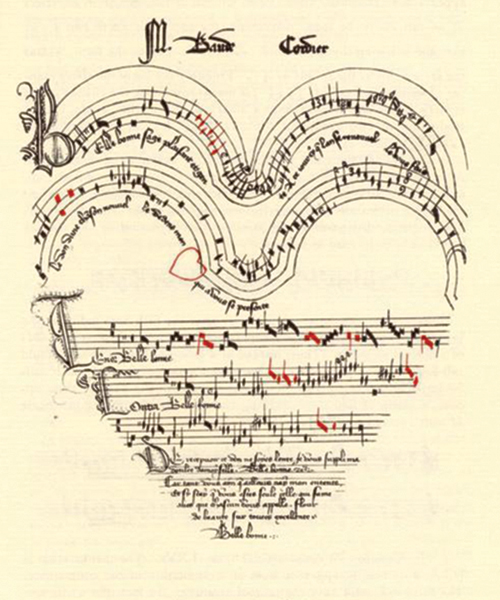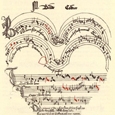
Since the beginning of musical notation, composers have tried to communicate musical expression to performers. Interestingly, those communications have increased and become much more detailed throughout the years.
Even in the 1300s composers were experimenting with ways to communicate musical direction to players. The image on the right is a photo of Baude Cordier’s chanson “Belle, bonne, sage,” from the Chantilly Manuscript, which dates from between 1350 and 1400. “The manuscript is one of the classic examples of ars subtilior, which requires red notes, or coloration to indicate changes in note lengths from their normally written values.”
Initially, composers indicated tempo and expression with meter choices. A 2/4 time signature called for a faster tempo than a 4/4 time signature, while 6/8 was faster than 6/4. Words were not necessary because the time signatures said it all. In the Baroque era composers indicated tempo by adding dance names and their styles, such as Siciliano or Minuet, to the time signatures already in use. This told players how fast or slow to perform a work and in what style. There were very few dynamic markings in Baroque music. Think about how rarely Bach wrote a f or p in his sonatas that you have played. He did indicate dynamics once in a while but generally left them up to the performer. He assumed that, armed with time signatures and movement titles, players would instinctively know what the tempo and general mood should be. Everyone knew how to dance a Siciliano, right? Maybe not today, but back then they knew what to do.
Expressive markings on individual notes, such as accents and staccato marks, were not used often until the Romantic era. From that point on to modern times composers have included more and more markings. It is interesting to compare Bach’s Partita, Debussy’s Syrinx, Edgar Varese’s Density 21.5, and Berio’s Sequenza for flute – all excellent examples of solo flute pieces from widely varied time periods. The Partita was written in the 1720s; Syrinx was written in 1913; Density 21.5 is from 1936; and Sequenza was written in 1958.
A comparison of the expressive indications in these four works tells the entire story. Partita has basic notation and movement names only. Everything else is left up to the performer. Syrinx includes phrasing, dynamics, Italian expressive terms, and specific articulation. Varese seems to apply an articulation mark to every note, as does Berio in Sequenza, the only difference being that phrasing in Berio’s piece is somewhat ambiguous. He tells you how many notes should fit within a given time frame. All in all, it seems that composers in the old days trusted musicians a bit more than they do today.
Of additional interest are those instances when a composer bars the groups of 16ths in order to convey phrasing and directional movement. The Karg-Elert etudes are a good example of this. Instead of grouping four 16th notes together, he groups the last three notes of a group of four with the first note of the next beat. This is clearly a musical expression indication that those notes should move toward the next beat and not be shackled to the first note of that specific group of four. I confess that I played those etudes in high school for the first time and never noticed those grouping variances. It was only when I began teaching them decades later that I saw the notation anew and realized that he had grouped the notes a special way for a reason.
I was a fairly decent young flutist, so how could I have missed that unusual notation? That notes were not barred in a conventional way did not even enter my consciousness, although I played the etudes correctly – that is, with correct notes and rhythm. Is that enough? Of course it isn’t. We must learn to look a bit deeper. We must follow the ink, and look for the clues. Composers have written them in everywhere. Musicians have only to interpret those clues. The next time you start a new composition, set up a little game for yourself. Instead of focusing on the notes and rhythm, take a pencil to the expression marks; circle them, look up any words you don’t know, and write the translation on your music. Explore every little mark. What is the composer trying to communicate to you? How can you communicate that to the audience? That is our job; we follow the ink and translate it for the audience.






